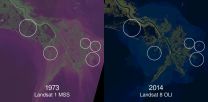Wealthy countries may feel flooding effects more in the future
2015-08-06
(Press-News.org) This news release is available in Japanese.
Today, many wealthy countries are able to mitigate, to some degree, their risk of delta flooding through vulnerability-reducing investments, but a new model suggests that this mitigation may not be sustainable in the long-term. Ultimately, wealthy countries could be feeling the strain of floods to a similar degree as developing countries. To calculate a given delta population's risk of flooding, Zachary Tessler and colleagues accounted for the population's probability of a damage-producing event, how the population's exposure to these hazards may change over time due to changing climate variables, and the population's vulnerability to these adverse events; this latter factor, the authors argue, is strongly influenced by the wealth of the delta's country since high GDP is a good proxy for financial capacity to mitigate the impact of flooding, from household to region-wide scales. The researchers applied these calculations to 48 major coastal deltas, spanning a range of climate and socioeconomic contexts, with a total estimated current population of more than 340 million. Even though deltas in wealthier countries, such as the Mississippi and Rhine deltas, had similar probability of flooding events and rates of exposure over time compared to some other deltas, their resulting risk levels were much more stable, with risk trends among the lowest of all the deltas in the study. However, when the researchers re-calculated the risks over time taking into account long-term rising infrastructure costs, these deltas had the greatest increases in vulnerability. The authors say investments that manage the drivers behind human-caused delta degradation, rather than its symptoms, will be necessary to sustain deltas in the long-term. A Perspective by Stijn Temmerman delves further into the problems - and solutions - discussed in this paper.
INFORMATION:
Article #12: "Profiling risk and sustainability in coastal deltas of the world," by Z.D. Tessler; C.J. Vörösmarty at City University of New York in New York, NY; C.J. Vörösmarty; M. Grossberg; I. Gladkova; H. Aizenman at City College of New York in New York, NY; J. Syvitski at University of Colorado, Boulder in Boulder, CO; E. Foufoula-Georgiou at University of Minnesota in Minneapolis, MN.
[Attachments] See images for this press release:

ELSE PRESS RELEASES FROM THIS DATE:
2015-08-06
This news release is available in Japanese.
As a devastating earthquake ruptured Nepal on April 25, 2015, nearby GPS networks continuously recorded measurements at very close distances. In a new study, these data provide the scientific community with unique insights into megathrust earthquakes, which occur when two tectonic plates converge and one plate is forced underneath the other, and may help hazard assessment teams improve earthquake hazard models. To better understand the sudden and intense changes megathrust earthquakes entail, John Galetzka et al. analyzed ...
2015-08-06
This news release is available in Japanese.
In the face of the recent Ebola outbreak, some good news emerges: a preclinical study testing the efficacy of the Ebola vaccine VSV-EBOV against the newly emerged West African Ebola strain shows complete protection when administered seven days before infection in nonhuman primates, and partial protection when administered three days before infection. The positive results of this study further reveal the mechanisms by which an effective immune response is mounted against the Ebola virus, aspects of which have been unclear. ...
2015-08-06
Darwinian selection can be used to evolve robot controllers able to efficiently self-organize their tasks. Taking inspiration from the way in which ants organise their work and divide up tasks, Eliseo Ferrante and colleagues evolved complex robot behaviors using artificial evolution and detailed robotics simulations.
Just like social insects such as ants, bees or termites teams of robots display a self-organized division of labor in which the different robots automatically specialized into carrying out different subtasks in the group, says new research publishing in PLOS ...
2015-08-06
Big data sets are important tools of modern science. Mining for correlations between millions of pieces of information can reveal vital relationships or predict future outcomes, such as risk factors for a disease or structures of new chemical compounds.
These mining operations are not without risk, however. Researchers can have a tough time telling when they have unearthed a nugget of truth, or what amounts to fool's gold: a correlation that seems to have predictive value but actually does not, as it results just from random chance.
A research team that bridges academia ...
2015-08-06
Autopsies of nearly every patient with the lethal neurodegenerative disorder amyotrophic lateral sclerosis (ALS), and many with frontotemporal dementia (FTD), show pathologists telltale clumps of a protein called TDP-43. Now, working with mouse and human cells, Johns Hopkins researchers report they have discovered the normal role of TDP-43 in cells and why its abnormal accumulation may cause disease.
In an article published Aug. 7 in Science, the researchers say TDP-43 is normally responsible for keeping unwanted stretches of the genetic material RNA, called cryptic ...
2015-08-06
For more than 20 years, Caltech geologist Jean-Philippe Avouac has collaborated with the Department of Mines and Geology of Nepal to study the Himalayas--the most active, above-water mountain range on Earth--to learn more about the processes that build mountains and trigger earthquakes. Over that period, he and his colleagues have installed a network of GPS stations in Nepal that allows them to monitor the way Earth's crust moves during and in between earthquakes. So when he heard on April 25 that a magnitude 7.8 earthquake had struck near Gorkha, Nepal, not far from Kathmandu, ...
2015-08-06
Case Western Reserve scientists may have uncovered a molecular mechanism that sets into motion dangerous infection in the feet and hands often occurring with uncontrolled diabetes. It appears that high blood sugar unleashes destructive molecules that interfere with the body's natural infection-control defenses.
The harmful molecules -- dicarbonyls -- are breakdown products of glucose that interfere with infection-controlling antimicrobial peptides known as beta-defensins. The Case Western Reserve team discovered how two dicarbonyls -- methylglyoxal (MGO) and glyoxal (GO) ...
2015-08-06
ROSEMONT, Ill.--According to a new study in the Journal of the American Academy of Orthopaedic Surgeons (JAAOS), imaging studies necessary to diagnose traumatic injuries sustained by pregnant women are safe when used properly.
During pregnancy, approximately 5 to 8 percent of women sustain traumatic injuries, including fractures and muscle tears. To help evaluate and manage these injuries, orthopaedic surgeons often recommend radiographs and other imaging studies. "While care should be taken to protect the fetus from exposure, most diagnostic studies are generally safe, ...
2015-08-06
Women experience more emotional pain following a breakup, but they also more fully recover, according to new research from Binghamton University.
Researchers from Binghamton University and University College London asked 5,705 participants in 96 countries to rate the emotional and physical pain of a breakup on a scale of one (none) to 10 (unbearable). They found that women tend to be more negatively affected by breakups, reporting higher levels of both physical and emotional pain. Women averaged 6.84 in terms of emotional anguish versus 6.58 in men. In terms of physical ...
2015-08-06
PITTSBURGH-- In the era of launching Kickstarter campaigns to pay for just about anything, Carnegie Mellon University ethicists warn that the trend of patients funding their own clinical trials may do more harm than good.
CMU's Danielle Wenner and Alex John London and McGill University's Jonathan Kimmelman co-wrote a column in Cell Stem Cell outlining how patient-funded trials may seem like a beneficial new way to involve more patients in research and establish new funding opportunities, but instead they threaten scientific rigor, relevance, efficiency and fairness.
"Patient-funded ...
LAST 30 PRESS RELEASES:
[Press-News.org] Wealthy countries may feel flooding effects more in the future

